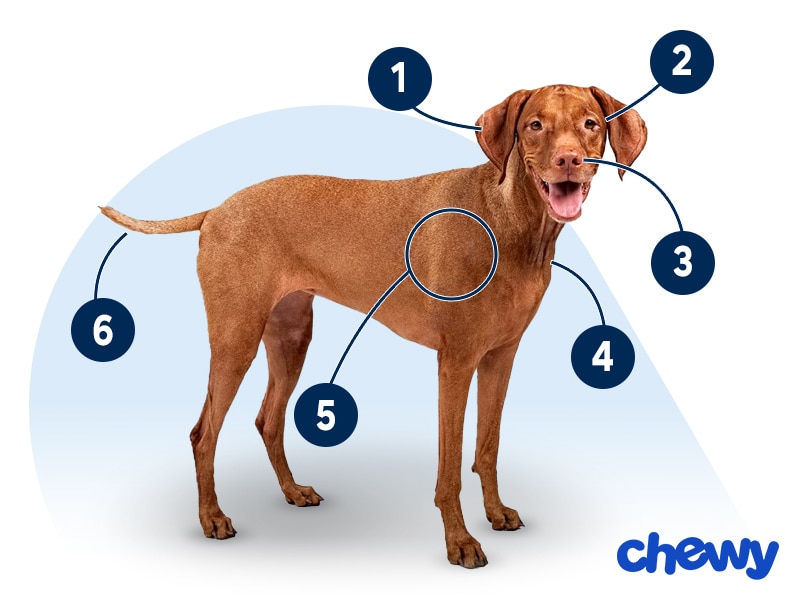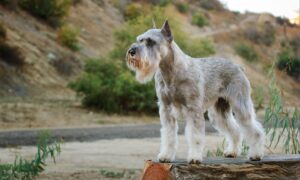Vizsla
Updated July 29, 2025
Vizsla
Updated July 29, 2025
This wiggly, wild dog is lightning fast, whether you’re on a run or hanging at the dog park—but rest assured, the Vizsla will never actually leave you behind. They’re very much a Velcro dog at heart who dotes on their parents as much as they want to be doted on.
Athletic, Courageous, Gentle
44–60 pounds
21–24 inches
12–14 years
Golden Rust
The Vizsla is a high-energy pup who’s ready for anything—and they’re delighted to go wherever you want. A hike? Absolutely. A boating adventure? Get the life jacket ready! Your lap while bingeing your new favorite series? They’re on it! (Yes, your Vizsla will literally be on your lap and might be blocking your view, but be patient with them—they have no idea they’re not really the size of a Pomeranian.)
These kind, gentle-hearted dogs need their people as much as they need the great outdoors. If you love adventure and affection, the Vizsla is your soul pup.
Vizsla Characteristics
Vizsla Appearance
A Vizsla dog’s smooth golden–rust coat and delicate droopy ears are adorably irresistible. They also have a lean, muscular frame, gentle eyes, and a curious, intelligent face.

- Ears
Vizsla ears hang close to the cheeks and are thin and silky with rounded edges.
- Eyes
Vizsla eyes are medium in size and tend to blend in with the dog’s coat color.
- Nose
Their nose is rounded and the same golden-rust color as their fur.
- Coat Length
The Vizsla dog breed is short-coated with smooth, dense fur.
- Coat Color
A Vizsla’s coat is shades of golden rust.
- Tail
While it was once common to dock a Vizsla’s tail, nowadays many of these pups have their tail intact. Many groups, including the American Veterinary Medical Association, oppose tail docking, and many countries as well as U.S. states have banned the practice.
Vizsla Temperament
Whether bounding, wiggling, or racing, the Vizsla is a dog on the go. Their high-energy personality wants adventure, and they want it now.
But these pups are more than just their sporty facades. These star athletes are also Velcro dogs—if you thought only tiny pups cozied up to their people, think again. Vizslas are obsessed with their person and will treat them like royalty (which, of course, they think you are).
Vizslas are friendly dogs with a playful demeanor that comes out wherever they are. They’ll likely get along with other pups in the house, though they may need some help to socialize with cats due to their prey drive.
They’re easygoing with most people, though, and are friendly even with strangers. Having a Vizsla in a home with kids or babies is a great idea, as they tend to be gentle and kind family dogs.
These bright dogs are smart enough to learn things quickly, making them highly trainable. Their intelligence has earned them high honors, including accolades for being guide dogs and search-and-rescue dogs.
How to Care for a Vizsla
Vizslas are pretty low-maintenance when it comes to grooming, but you’ll need to devote lots of time to training and exercise.
Grooming
Training
Diet
Exercise
Environment
Vizsla Health
The average Vizsla lifespan is 12–14 years. Here are some health issues to be aware of.
- Eye problems: Vizslas may develop ocular melanosis, a congenital disorder that can lead to glaucoma. Glaucoma occurs when fluid in the eyes doesn’t drain and pressure builds. It’s painful and can result in blindness, so it’s a medical emergency. Treatment is topical medications or surgery. The Vizsla dog breed is also susceptible to entropion, an eyelid abnormality in which a dog’s eyelid rolls in on itself (potentially causing pain and ulcers on the cornea). Surgery is the most successful treatment option.
- Progressive retinal atrophy: Also known as PRA, this condition is a degenerative, heredity eye disease that leads to blindness. While there’s no cure, pups who lose their eyesight tend to adapt well and can still live full, happy lives.
- Epilepsy: Vizslas are prone to seizures caused by epilepsy, which typically begins between 6 months and 5 years old. It’s treated with medication.
- Hip dysplasia: Hip dysplasia is when the hip joint doesn’t develop properly. It’s an inherited condition that can be made worse if a pup is overweight. It eventually leads to arthritis and pain. More severe cases may require surgery, but the condition is often treated with medications, joint supplements, special diets, weight management, and/or physical therapy.
- Hypothyroidism: Common in this breed, hypothyroidism includes symptoms like lethargy, hair loss, ear and skin infections, and weight gain. A blood test can diagnosis it, and treatment is a daily oral medication.
Vizsla History
The Vizsla’s history is inextricably linked to the Magyar people who traversed a wide-ranging swath of Asia and Europe centuries ago, before settling in what is now Hungary.
The Magyars’ prowess on horseback was legendary, as was their ability to ride quickly with equally fast dogs at their sides. Their canine companions had reddish-brown coats—and today’s Vizslas are their descendants.
Later, Vizslas became the favored hunting breed of Hungarian nobles. But by the end of World War I, the Vizsla dog breed was nearly extinct.
With just a handful of dogs in existence, fans of the Hungarian Vizsla were able to repopulate the breed, and they began to arrive in the U.S. after World War II. The American Kennel Club recognized the Vizsla in 1960.
If you’re interested in purchasing a puppy, know that the typical Vizsla dog price is about $2,000. Pick a responsible breeder if you go this route.
You can also consider adopting a Vizsla. Reach out to Vizsla rescue organizations, such as the Vizsla Rescue for Southern California, keep an eye out at your local animal shelter, or search Chewy’s database of adoptable dogs in your area.








